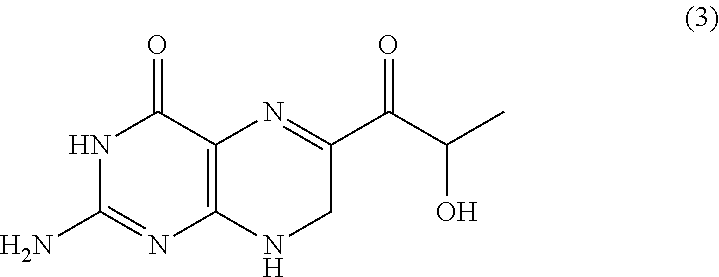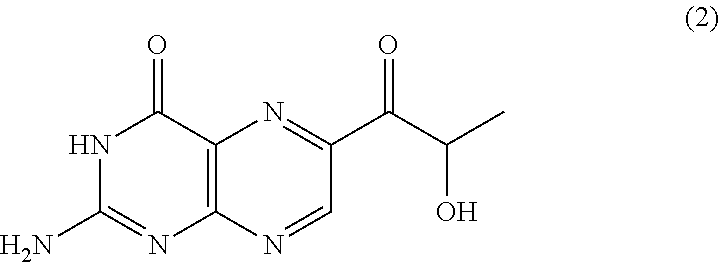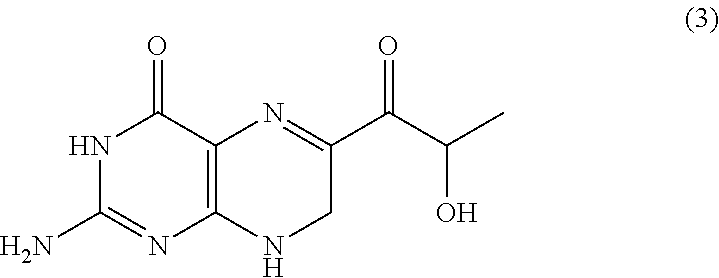Method for producing sepiapterin and tetrahydrolactoylpterin
a technology of tetrahydrolactoylpterin and sepiapterin, which is applied in the field of sepiapterin, lactoylpterin and tetrahydrolactoylpterin production, can solve the problems of blocking bh4 from reaching cerebral nervous cells and unable to reach the blood-brain barrier, and achieves high yield
- Summary
- Abstract
- Description
- Claims
- Application Information
AI Technical Summary
Benefits of technology
Problems solved by technology
Method used
Image
Examples
referential example 1
Synthesis of Compound (1)
[0129]
[0130]Under argon atmosphere, tetrapropylammonium perruthenate, 4-methylmorpholine N-oxide, and compound (D) were added to acetonitrile in the presence of MS-4A and the mixture was stirred at 60° C. After one hour, the reaction mixture was filtered through Celite™545, and 10% aqueous ammonium chloride solution was added to the filtrate, followed by extraction with ethyl acetate. The extract was dried over magnesium sulfate, concentrated and separated and purified through silica gel column chromatography. The thus-separated product was decanted by use of toluene, to thereby yield compound (1).
example 1
Synthesis of S-lactoylpterin (2)
[0131]
[0132]Methanol (50 mL) and 3-mol / L hydrochloric acid (250 mL) were added to 1-(2-amino-4-cyclohexyloxypteridin-6-yl)-2S-methoxymethoxypropan-1-one (compound (1)) (24.7 g, 68.2 mmol), and the mixture was stirred at 50° C. for 3 hours. The pH of the reaction mixture was adjusted with aqueous sodium hydroxide solution to 7. The formed crystals were recovered through filtration and dried under reduced pressure, to thereby yield S-lactoylpterin (15.1 g, 64.2 mmol, yield: 94%). (S-lactoylpterin: (2))
[0133]1H NMR (DMSO-d6): δ / ppm=1.32 (d, 3H, J=6.8 Hz), 5.16 (br, 1H), 5.32 (q, 1H, J=6.8 Hz), 9.09 (s, 1H)
example 2
Synthesis of 1-(2-amino-4-cyclohexyloxypteridin-6-yl)-2S-hydroxypropan-1-one
[0134]
[0135]THF (40 mL) and 70% tetrabutylammonium fluoride (6.92 g, 18.5 mmol) were added to 1-(2-amino-4-cyclohexyloxypteridin-6-yl)-2S-t-butyldimethylsilanoxypropan-1-one (compound (1)) (4.0 g, 9.27 mmol), and the mixture was stirred at 10° C. or lower for 2 hours. Water was added to the reaction mixture, and extraction with chloroform was performed. The obtained organic layer was dehydrate and concentrated under reduced pressure. The thus-recovered crude product was purified through flash chromatography, to thereby yield 1-(2-amino-4-cyclohexyloxypteridin-6-yl)-2S-hydroxypropan-1-one (2.09 g, 6.59 mmol, yield: 71%).
[0136]1H NMR (DMSO-d6): δ / ppm=1.38 (d, 3H, J=6.6 Hz), 1.37-1.79 (m, 8H), 1.98-1.99 (m, 2H), 5.20 (d, 1H, J=6.3 Hz), 5.34 (d.q., 1H, J=6.6 Hz), 5.29-5.37 (m, 1H), 7.68 (br, 1H), 7.82 (br, 1H), 9.22 (s, 1H)
PUM
| Property | Measurement | Unit |
|---|---|---|
| pKa | aaaaa | aaaaa |
| pKa | aaaaa | aaaaa |
| temperature | aaaaa | aaaaa |
Abstract
Description
Claims
Application Information
 Login to View More
Login to View More - R&D
- Intellectual Property
- Life Sciences
- Materials
- Tech Scout
- Unparalleled Data Quality
- Higher Quality Content
- 60% Fewer Hallucinations
Browse by: Latest US Patents, China's latest patents, Technical Efficacy Thesaurus, Application Domain, Technology Topic, Popular Technical Reports.
© 2025 PatSnap. All rights reserved.Legal|Privacy policy|Modern Slavery Act Transparency Statement|Sitemap|About US| Contact US: help@patsnap.com



